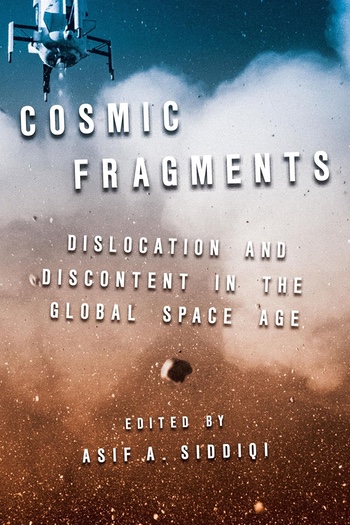Review: Cosmic Fragmentsby Jeff Foust
|
| One examines how the mass media covered the Apollo-Soyuz Test Project 50 years ago this month, and makes the case that such coverage helped enable the mission. |
That, however, is true of many fields, where the depth of specialization is achieved through the sacrifice of breadth of participation. That came to mind when reading Cosmic Fragments, a collection of essays edited by spaceflight historian Asif Siddiqi. The book was a project, he writes in the introduction, “to wrest the history of space exploration from its normative fetishization of machines, men, and manifest destiny” and incorporate topics normally excluded, from environmental effects to the displacement of indigenous peoples. The book is the result of a years-long effort that included a symposium planned for 2020 but cancelled because of COVID, instead held online the following year.
The essays are thematically split into four parts, titled Landscape, Empire, Waste, and Rupture. They cover topics ranging from how the development of spaceports affected local environments and people to tracing changing Russian views on spaceflight through post-Soviet film.
The book examines some interesting themes, such as how space powers placed launch sites in “empty” areas that often were anything but. One chapter explores how NASA often described the site of the Kennedy Space Center in the 1960s as “empty, tropical, and primitive,” even though the region for centuries has been home to native peoples and, more recently, a settlement established by freed slaves that was cleared to make way for the spaceport. Similar issues are described in places like Kourou in French Guiana and Woomera in Australia. It is also not solely a Western issue: one chapter describes how the early Indian space program selected Sriharikota Island for its spaceport, dispersing a native population there, while another discusses local opposition to Russian launches from the Baikonur Cosmodrome, in part because of accidents that spilled toxic propellant.
There are fascinating essays on other topics as well. One examines how the mass media covered the Apollo-Soyuz Test Project 50 years ago this month, and makes the case that such coverage helped enable the mission by encouraging a reluctant Soviet Union to participate given public support for cooperation versus competition by the end of the 1960s. Another traces how international space cooperation and competition is portrayed in movies in the late 1990s through the 2010s, from acclaimed films like Contact and Hidden Figures to, ah, Geostorm. (The focus on film, unfortunately, means that depictions in television are ignored, with the rich alt-history of For All Mankind only mentioned in passing.)
| Another author has a similar view of those suborbital spaceflights, calling them a “pale, ersatz version of the US-Soviet space race” that “achieved less, and for more money” than the 1961 flights of Yuri Gagarin and Alan Shepard. |
Some authors, though, show a disdain, it not animus, towards commercial spaceflight and some of its leading backers, often couched in academic language. One essay starts by noting the suborbital flights of Richard Branson and Jeff Bezos in 2021 took place amid the pandemic, climate change, and a rise in authoritarianism. “Interrogating these phenomena as co-constituted rather than coincidental provides greater clarity on the material relations and social conditions through which contemporary human engagements with outer space are being produced,” the essay states. Outside of a particular slice of academia, it’s not clear that sentence provides much in the way of greater clarity. (The author does not help themselves when stating, in the same paragraph, “Unlike most space-related activities taking place globally, these flights served no scientific purpose.” Most contemporary space-related activities involve commercial or national security applications, with science lagging far behind.)
Another author has a similar view of those suborbital spaceflights, calling them a “pale, ersatz version of the US-Soviet space race” that “achieved less, and for more money” than the 1961 flights of Yuri Gagarin and Alan Shepard. In a heavily footnoted academic work, that eyebrow-raising claim that Bezos and Branson spent more on their flights than the US and USSR did on their first human spaceflights goes unsupported.
While there is a variety of topics explored in Cosmic Fragments, it’s clear that the audience for this book is primarily academia, particularly those in humanities. There is a lot that the space industry can learn from the humanities regarding perceptions and views about space, and a lot those in the humanities can learn about the technology and economics of spaceflight. Unfortunately, the two either ignore or talk past each other, which is not a new phenomenon (see “Review: Off-Earth”, The Space Review, April 10, 2023). The book ends up illustrating the importance for those studying or working in spaceflight to not just talk within their own groups but to also talk to each other, and to the broader public.
Note: we are now moderating comments. There will be a delay in posting comments and no guarantee that all submitted comments will be posted.
